Wavelet-Based Three-Dimensional Inversion for Geomagnetic Depth Sounding
Abstract
1. Introduction
2. Methods
2.1. Theory of GDS
2.2. General Inversion Approach
2.3. Wavelet Domain Inversion
2.4. L-BFGS Technique
3. Synthetic Examples
3.1. Selection of the Wavelet Order and Lp-Norm Measurement
3.2. Tests for Multiresolution Based on a Regular Network
3.3. More Realistic Tests Based on the Distribution of Real Observatories
4. Inversion of Actual Data
5. Conclusions
- (1)
- The db6 inversion is suitable for GDS inversion, and orders that are too high are not suitable, which may be related to the resolution of GDS;
- (2)
- The db6 inversion has a better resolution than the Lp-norm inversion for a model with multiscale anomalies, especially for small-scale and linear anomalies;
- (3)
- The inversion of global C-responses for 129 observatories presents features similar to those of previously published anomalies, but a much higher-resolution image of the mantle is given by db6 inversion.
Author Contributions
Funding
Institutional Review Board Statement
Informed Consent Statement
Data Availability Statement
Acknowledgments
Conflicts of Interest
References
- Kelbert, A.; Egbert, G.D.; Schultz, A. Non-Linear Conjugate Gradient Inversion for Global EM Induction: Resolution Studies. Geophys. J. Int. 2008, 173, 365–381. [Google Scholar] [CrossRef]
- Kelbert, A.; Schultz, A.; Egbert, G. Global Electromagnetic Induction Constraints on Transition-Zone Water Content Variations. Nature 2009, 460, 1003–1006. [Google Scholar] [CrossRef] [PubMed]
- Semenov, A.; Kuvshinov, A. Global 3-D Imaging of Mantle Conductivity Based on Inversion of Observatory C-Responses-II. Data Analysis and Results. Geophys. J. Int. 2012, 191, 965–992. [Google Scholar] [CrossRef]
- Yuan, Y.; Uyeshima, M.; Huang, Q.; Tang, J.; Li, Q.; Teng, Y. Continental-Scale Deep Electrical Resistivity Structure Beneath China. Tectonophysics 2020, 790, 228559. [Google Scholar] [CrossRef]
- Püthe, C.; Kuvshinov, A.; Khan, A.; Olsen, N. A New Model of Earth’s Radial Conductivity Structure Derived from over 10 Yr of Satellite and Observatory Magnetic Data. Geophys. J. Int. 2015, 203, 1864–1872. [Google Scholar] [CrossRef]
- Koyama, T.; Khan, A.; Kuvshinov, A. Three-Dimensional Electrical Conductivity Structure beneath Australia from Inversion of Geomagnetic Observatory Data: Evidence for Lateral Variations in Transition-Zone Temperature, Water Content and Melt. Geophys. J. Int. 2014, 196, 1330–1350. [Google Scholar] [CrossRef][Green Version]
- Li, S.; Weng, A.; Zhang, Y.; Schultz, A.; Li, Y.; Tang, Y.; Zou, Z.; Zhou, Z. Evidence of Bermuda Hot and Wet Upwelling from Novel Three-Dimensional Global Mantle Electrical Conductivity Image. Geochem. Geophys. Geosystems 2020, 21, e2020GC009016. [Google Scholar] [CrossRef]
- Zhang, Y.; Weng, A.; Li, S.; Yang, Y.; Tang, Y.; Liu, Y. Electrical Conductivity in the Mantle Transition Zone beneath Eastern China Derived from L1-Norm C-Responses. Geophys. J. Int. 2020, 221, 1110–1124. [Google Scholar] [CrossRef]
- Li, S.; Weng, A.; Li, J.; Shan, X.; Han, J.; Tang, Y.; Zhang, Y.; Wang, X. Deep Origin of Cenozoic Volcanoes in Northeast China Revealed by 3-D Electrical Structure. Sci. China Earth Sci. 2020, 63, 533–547. [Google Scholar] [CrossRef]
- Guo, J.; Lian, X.; Wang, X. Electrical Conductivity Evidence for the Existence of a Mantle Plume beneath Tarim Basin. Appl. Sci. 2021, 11, 893. [Google Scholar] [CrossRef]
- Liu, Y.; Farquharson, C.G.; Yin, C.; Baranwal, V.C. Wavelet-Based 3-D Inversion for Frequency-Domain Airborne EM Data. Geophys. J. Int. 2018, 213, 1–15. [Google Scholar] [CrossRef]
- Chiao, L.-Y.; Kuo, B.-Y. Multiscale Seismic Tomography. Multiscale Seism. Tomogr. 2001, 145, 517–527. [Google Scholar] [CrossRef]
- Chiao, L.-Y.; Liang, W.-T. Multiresolution Parameterization for Geophysical Inverse Problems. Geophysics 2003, 68, 199–209. [Google Scholar] [CrossRef]
- Uyeshima, M.; Schultz, A. Geoelectromagnetic Induction in a Heterogeneous Sphere: A New Three-Dimensional Forward Solver Using a Conservative Staggered-Grid Finite Difference Method. Geophys. J. Int. 2000, 140, 636–650. [Google Scholar] [CrossRef]
- Banks, R.J. Geomagnetic Variations and the Electrical Conductivity of the Upper Mantle. Geophys. J. R. Astron. Soc. 1969, 17, 457–487. [Google Scholar] [CrossRef]
- Grayver, A.V.; Munch, F.D.; Kuvshinov, A.V.; Khan, A.; Sabaka, T.J.; Tøffner-Clausen, L. Joint Inversion of Satellite-Detected Tidal and Magnetospheric Signals Constrains Electrical Conductivity and Water Content of the Upper Mantle and Transition Zone. Geophys. Res. Lett. 2017, 44, 6074–6081. [Google Scholar] [CrossRef]
- Munch, F.D.; Grayver, A.V.; Kuvshinov, A.; Khan, A. Stochastic Inversion of Geomagnetic Observatory Data Including Rigorous Treatment of the Ocean Induction Effect with Implications for Transition Zone Water Content and Thermal Structure. J. Geophys. Res. Solid Earth 2018, 123, 31–51. [Google Scholar] [CrossRef]
- Zhao, D. Global Tomographic Images of Mantle Plumes and Subducting Slabs: Insight into Deep Earth Dynamics. Phys. Earth Planet. Inter. 2004, 146, 3–34. [Google Scholar] [CrossRef]
- Daubechies, I. Ten Lectures on Wavelets; Society for Industrial and Applied Mathematics: Philadelphia, PA, USA, 1992; ISBN 9781611973280. [Google Scholar]
- Avdeev, D.; Avdeeva, A. 3D Magnetotelluric Inversion Using a Limited-Memory Quasi-Newton Optimization. Geophysics 2009, 74, F45–F57. [Google Scholar] [CrossRef]
- Nocedal, J.; Wright, S.J. Numerical Optimization, 2nd ed.; Thomas, V., Resnick, M., Robinson, S.M., Eds.; Springer Science + Business Media, LLC: New York, NY, USA, 2006; Volume 17, ISBN 0196-0202. [Google Scholar]
- Egbert, G.D.; Kelbert, A. Computational Recipes for Electromagnetic Inverse Problems. Geophys. J. Int. 2012, 189, 251–267. [Google Scholar] [CrossRef]
- Kuvshinov, A.; Olsen, N. A Global Model of Mantle Conductivity Derived from 5 Years of CHAMP, Ørsted, and SAC-C Magnetic Data.Pdf. Geophys. Res. Lett. 2006, 33, 1–5. [Google Scholar] [CrossRef]
- Daubechies, I.; Defrise, M.; De Mol, C. An Iterative Thresholding Algorithm for Linear Inverse Problems with a Sparsity Constraint. Commun. Pure Appl. Math. 2004, 57, 1413–1457. [Google Scholar] [CrossRef]
- Donoho, D.L. For Most Large Underdetermined Systems of Linear Equations the Minimal L1-Norm Solution Is Also the Sparsest Solution. Commun. Pure Appl. Math. 2006, 59, 797–829. [Google Scholar] [CrossRef]
- Zahedi, R.; Daneshgar, S.; Ali, M.; Seraji, N.; Asemi, H. Modeling and Interpretation of Geomagnetic Data Related to Geothermal Sources, Northwest of Delijan. Renew. Energy 2022, 196, 444–450. [Google Scholar] [CrossRef]
- Zahedi, R.; Babaee, A. Numerical and Experimental Simulation of Gas-Liquid Two-Phase Flow in 90-Degree Elbow. Alex. Eng. J. 2022, 61, 2536–2550. [Google Scholar] [CrossRef]
- Chave, A.D.; Thomson, D.J. Bounded Influence Magnetotelluric Response Function Estimation. Geophys. J. Int. 2004, 157, 988–1006. [Google Scholar] [CrossRef]
- Li, G.; Liu, X.; Tang, J.; Deng, J.; Hu, S.; Zhou, C.; Chen, C. Improved Shift—Invariant Sparse Coding for Noise Attenuation of Magnetotelluric Data. Earth Planets Sp. 2020, 72, 1–15. [Google Scholar] [CrossRef]
- Li, G.; Liu, X.; Tang, J.; Li, J.; Ren, Z.; Chen, C. De-Noising Low-Frequency Magnetotelluric Data Using Mathematical Morphology Fi Ltering and Sparse Representation. J. Appl. Geophys. 2020, 172, 103919. [Google Scholar] [CrossRef]
- Farquharson, C.G. Constructing Piecewise-Constant Models in Multidimensional Minimum-Structure Inversions. Geophysics 2008, 73, K1–K9. [Google Scholar] [CrossRef]
- Menke, W. Geophysical Data Analysis: Discrete Inverse Theory; Academi C Press, Inc.: Orlando, FL, USA, 1984. [Google Scholar]
- Chen, C.; Kruglyakov, M.; Kuvshinov, A. A New Method for Accurate and Efficient Modeling of the Local Ocean Induction Effects. Application to Long-Period Responses from Island Geomagnetic Observatories. Geophys. Res. Lett. 2020, 47, 1–9. [Google Scholar] [CrossRef]
- Yao, H.; Ren, Z.; Tang, J.; Zhang, K. A Multi-Resolution Finite-Element Approach for Global Electromagnetic Induction Modeling with Application to Southeast China Coastal Geomagnetic Observatory Studies. J. Geophys. Res. Solid Earth 2022, 127, e2022JB024659. [Google Scholar] [CrossRef]
- Everett, M.E.; Constable, S.; Constable, C.G. Effects of Near-Surface Conductance on Global Satellite Induction Responses. Geophys. J. Int. 2003, 153, 277–286. [Google Scholar] [CrossRef]


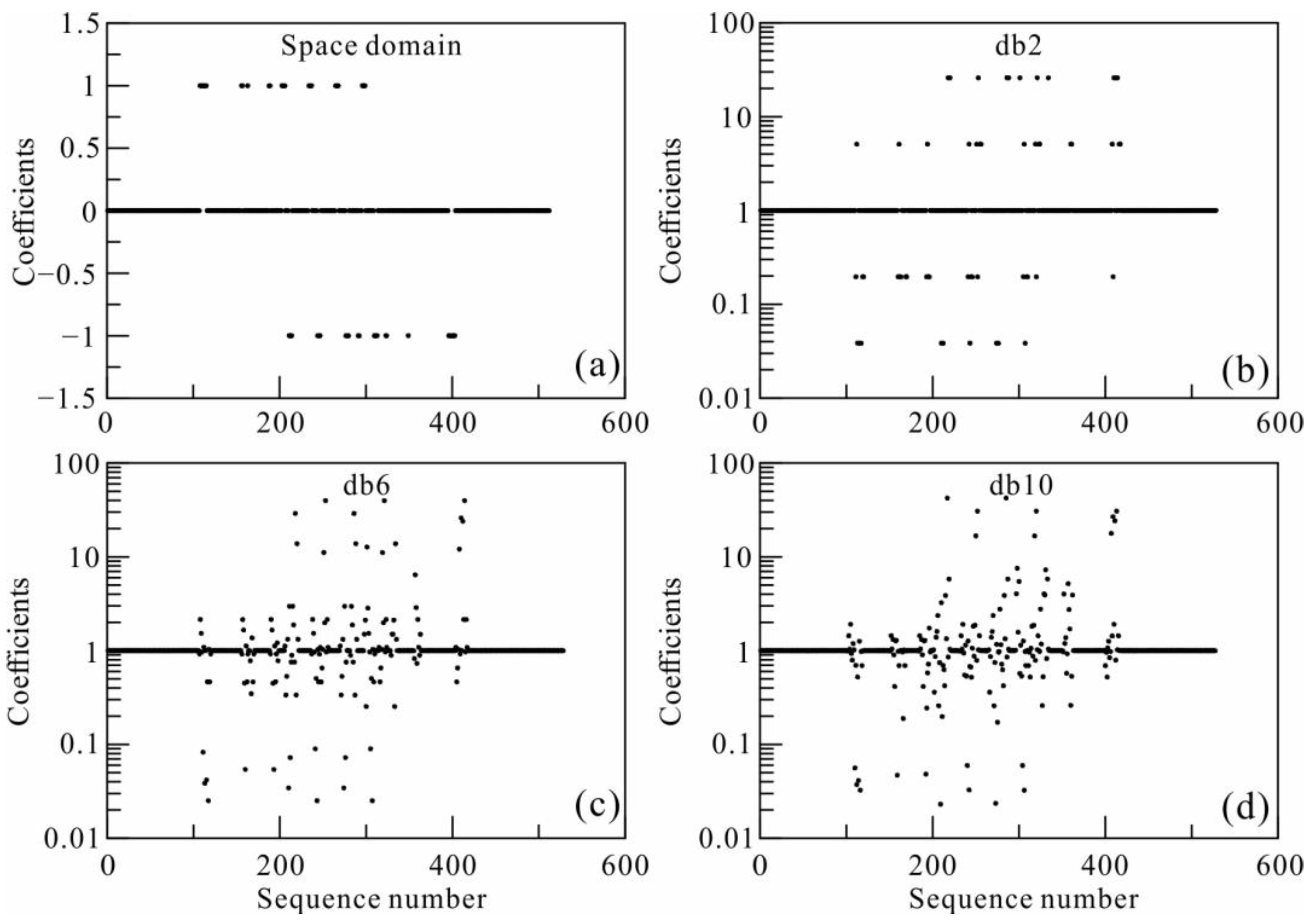
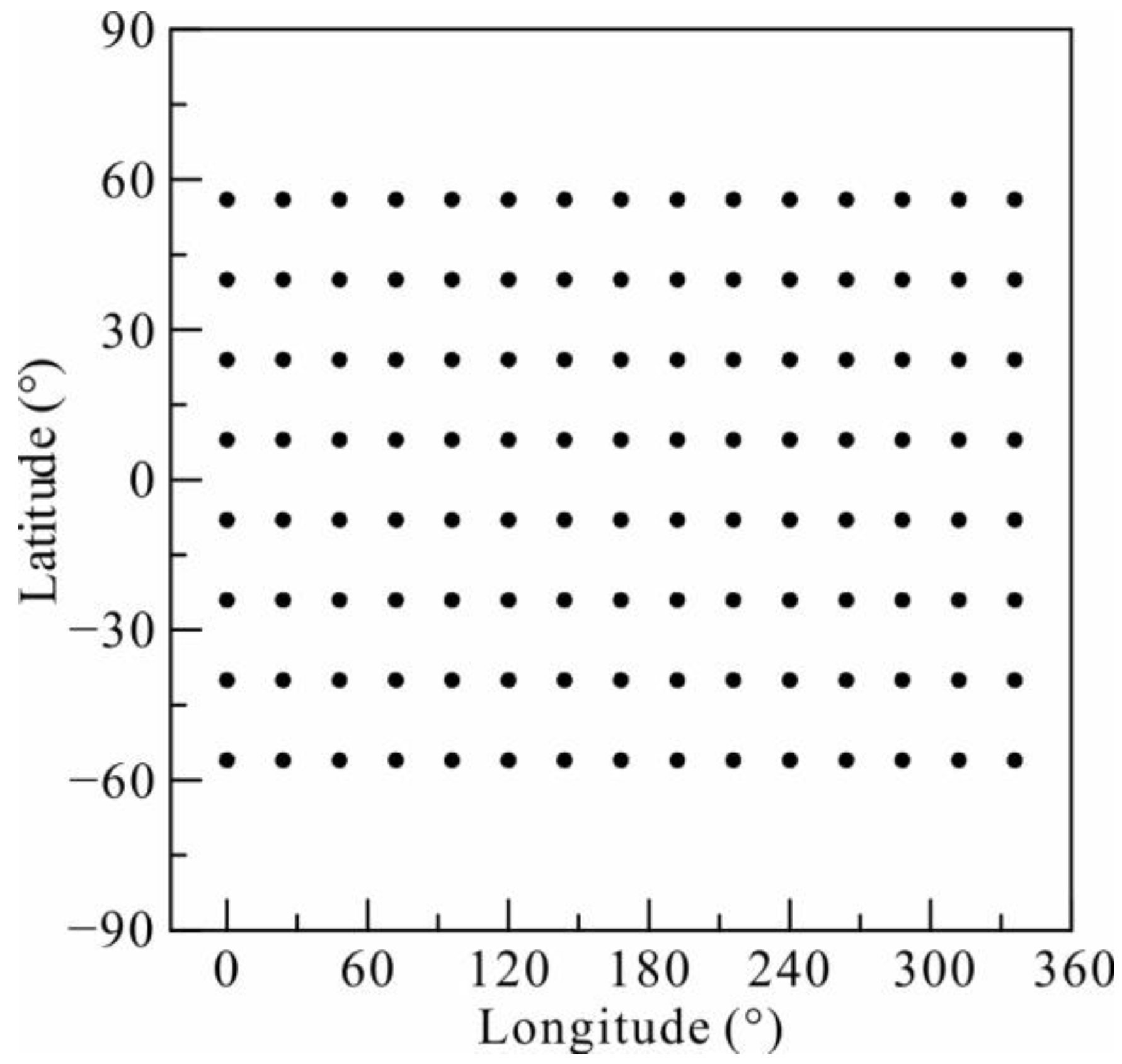

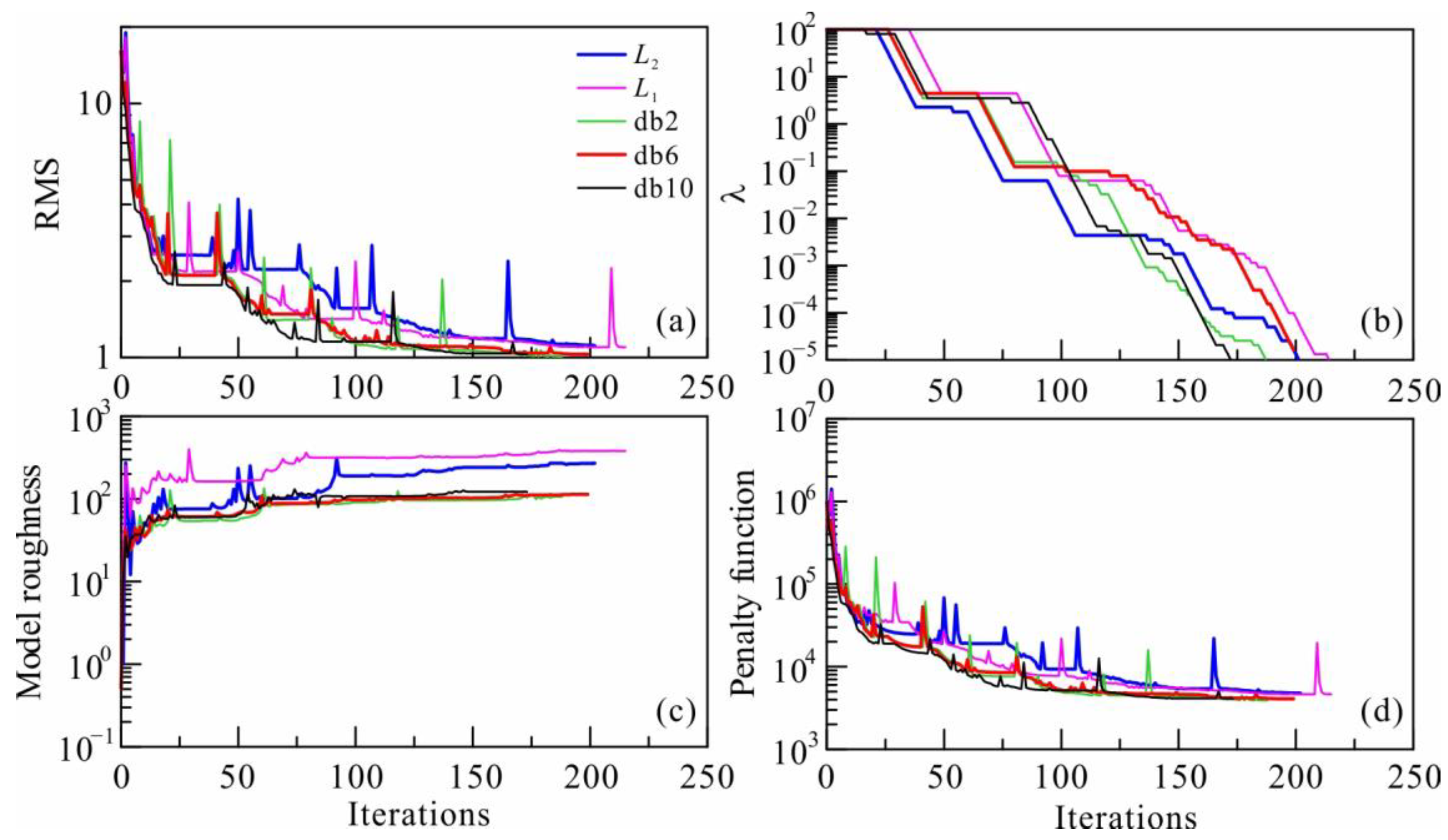
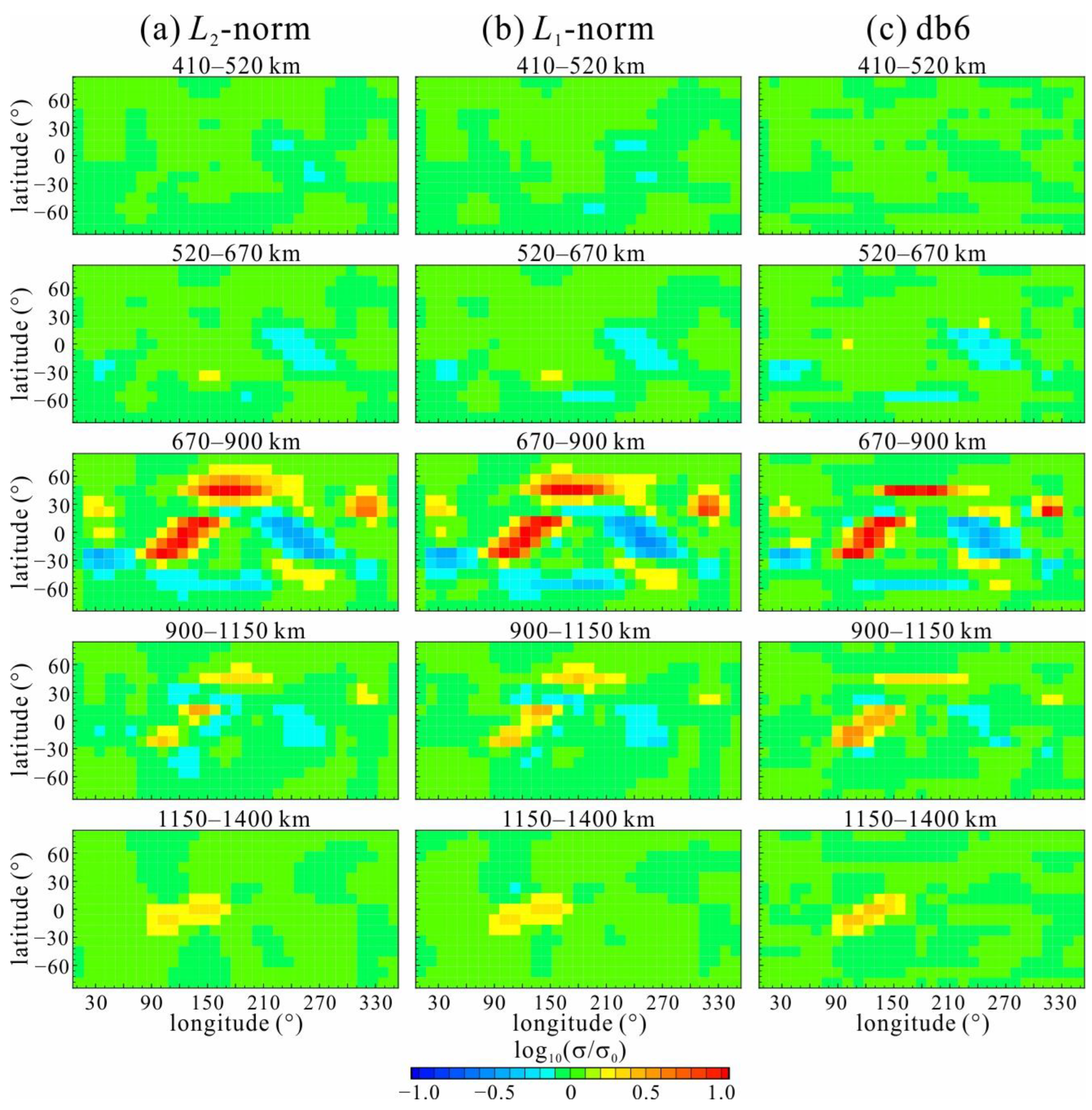
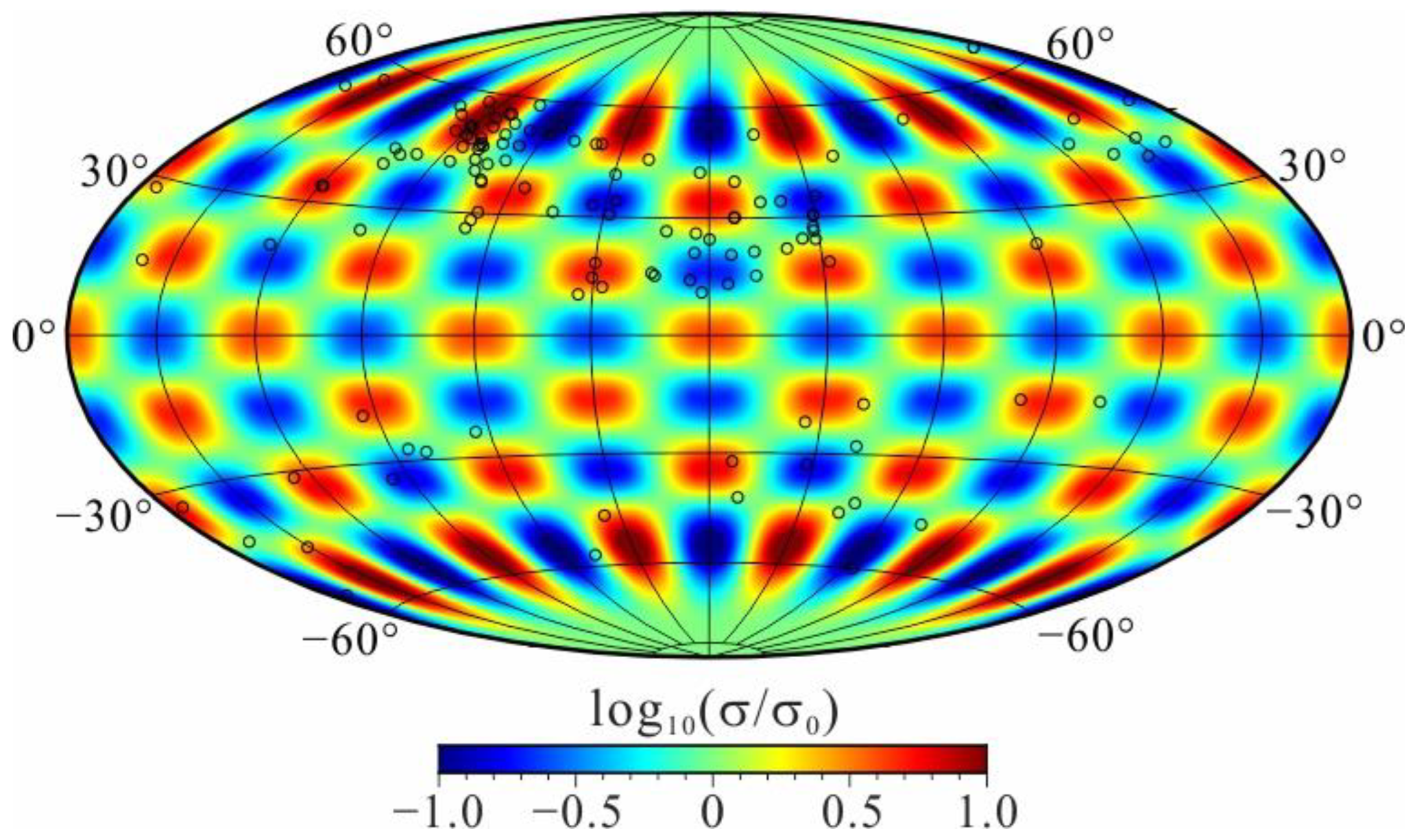
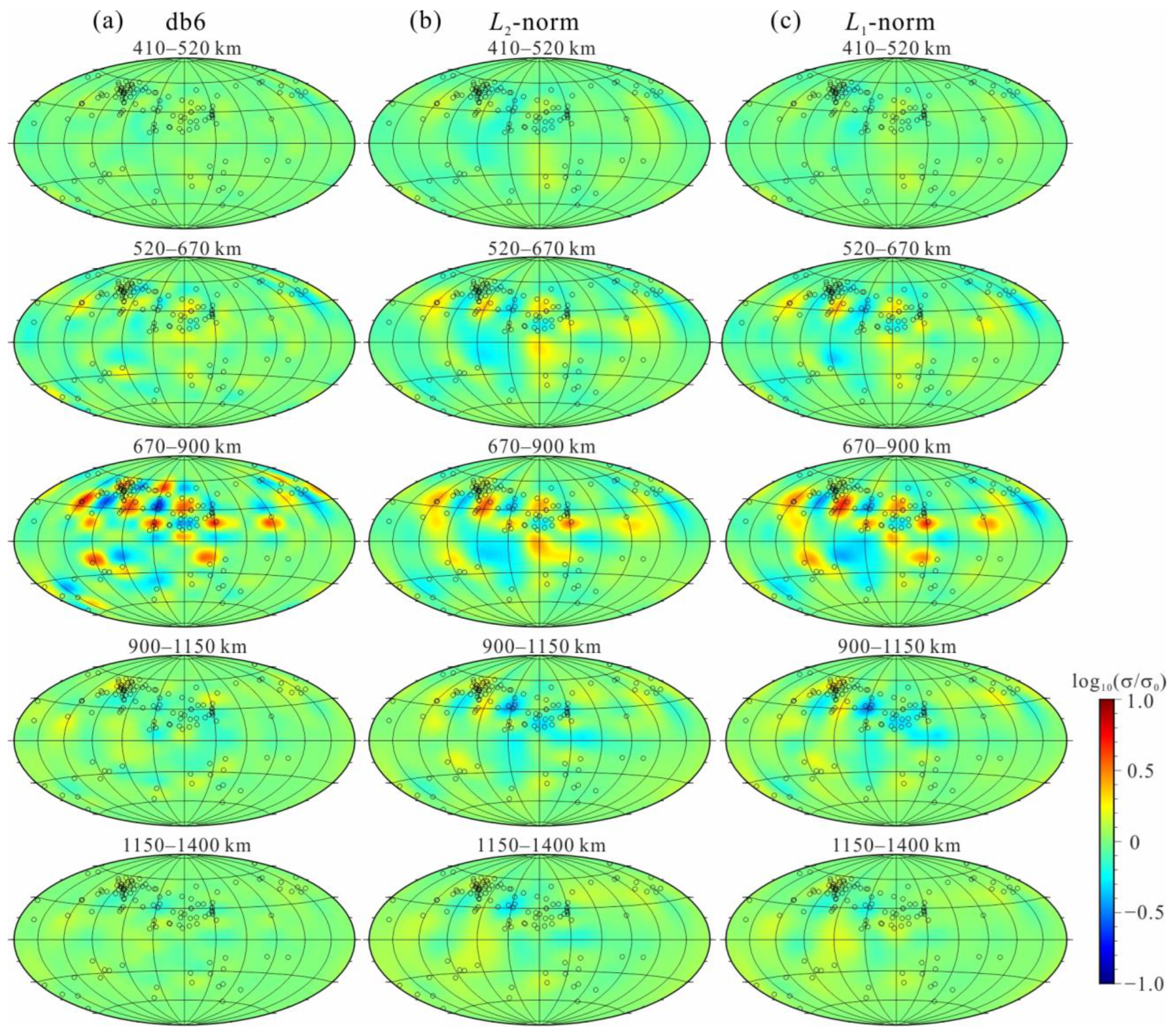
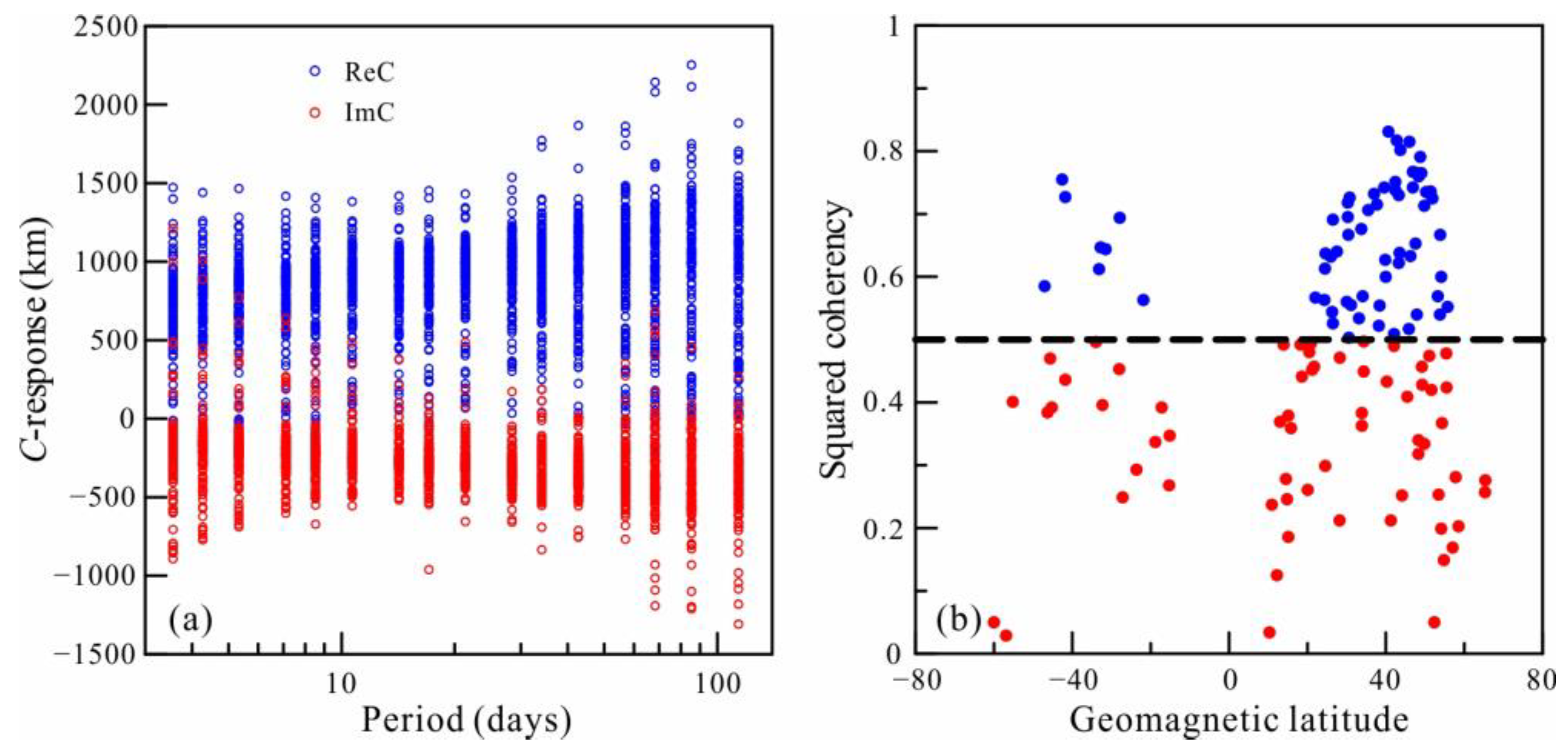
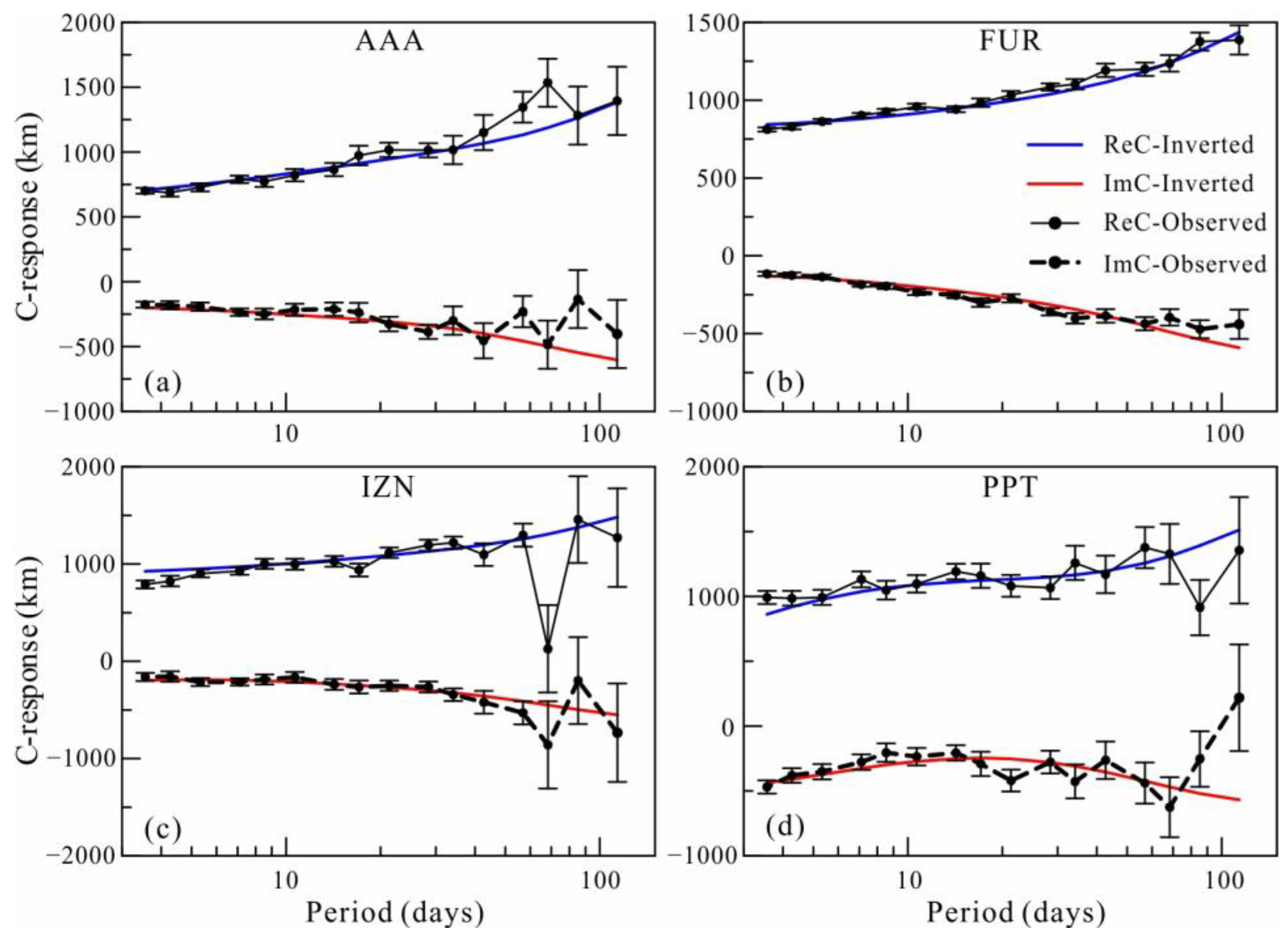
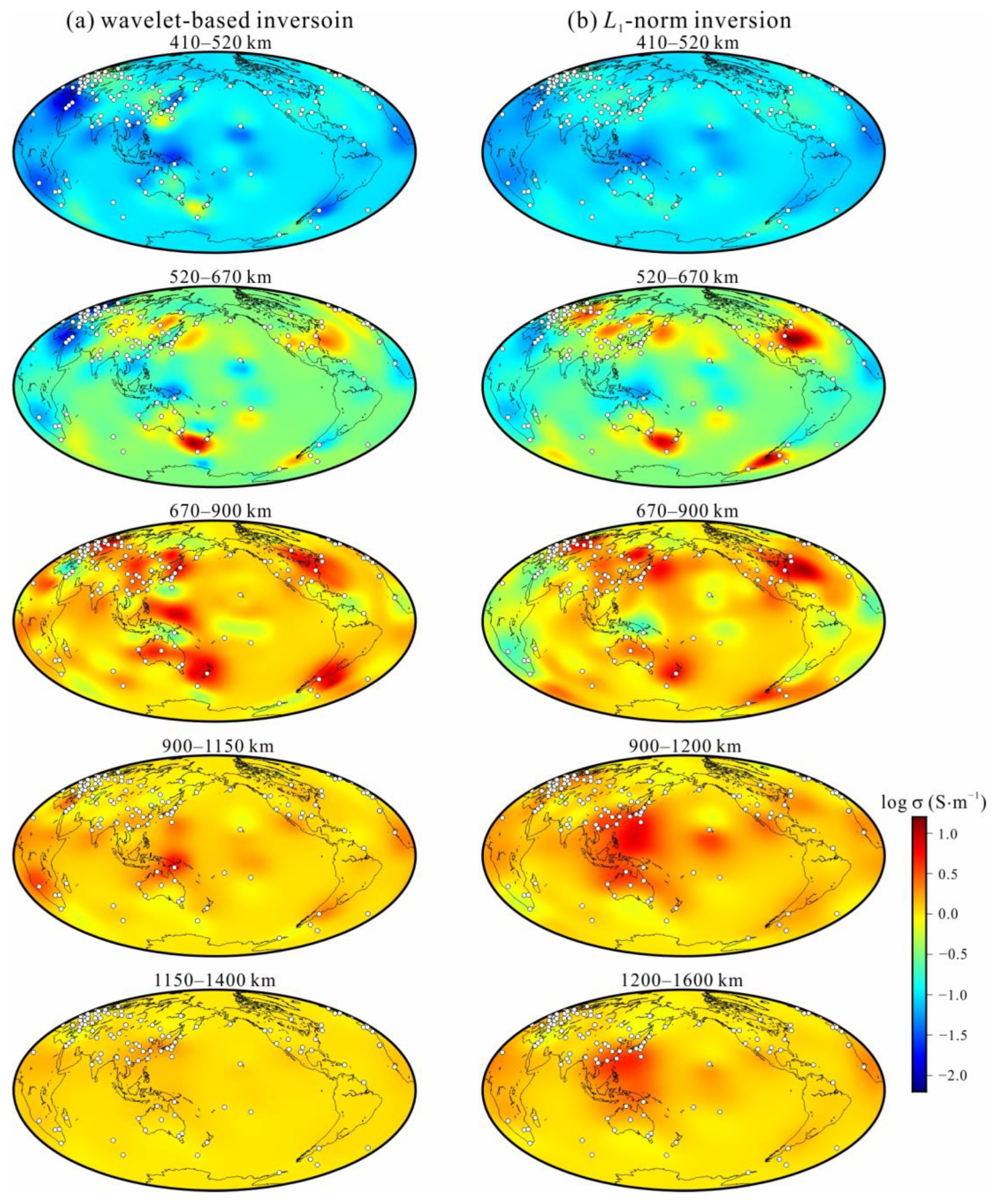
Publisher’s Note: MDPI stays neutral with regard to jurisdictional claims in published maps and institutional affiliations. |
© 2022 by the authors. Licensee MDPI, Basel, Switzerland. This article is an open access article distributed under the terms and conditions of the Creative Commons Attribution (CC BY) license (https://creativecommons.org/licenses/by/4.0/).
Share and Cite
Li, S.; Liu, Y. Wavelet-Based Three-Dimensional Inversion for Geomagnetic Depth Sounding. Magnetochemistry 2022, 8, 187. https://doi.org/10.3390/magnetochemistry8120187
Li S, Liu Y. Wavelet-Based Three-Dimensional Inversion for Geomagnetic Depth Sounding. Magnetochemistry. 2022; 8(12):187. https://doi.org/10.3390/magnetochemistry8120187
Chicago/Turabian StyleLi, Shiwen, and Yunhe Liu. 2022. "Wavelet-Based Three-Dimensional Inversion for Geomagnetic Depth Sounding" Magnetochemistry 8, no. 12: 187. https://doi.org/10.3390/magnetochemistry8120187
APA StyleLi, S., & Liu, Y. (2022). Wavelet-Based Three-Dimensional Inversion for Geomagnetic Depth Sounding. Magnetochemistry, 8(12), 187. https://doi.org/10.3390/magnetochemistry8120187






